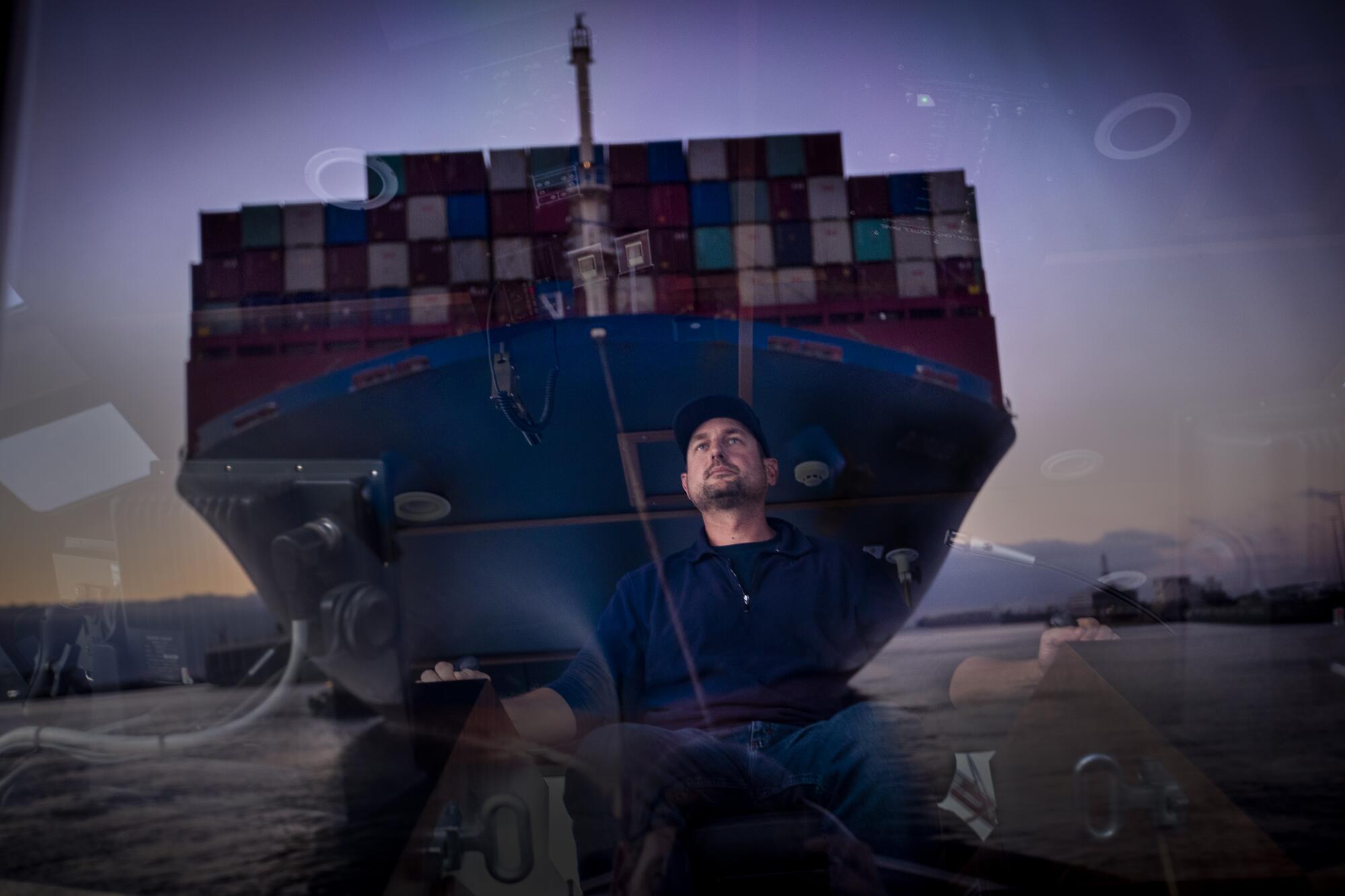
The sea is calm tonight. The breeze is light. An easy swell rolls beneath the Delta Teresa, a tugboat idling at the entrance to Long Beach Harbor.
In the darkness where sky and water meet, nearly three dozen tankers and container ships ride at anchor. Lights outline their skeletal shapes. Sunrise is two hours away, but clouds have lowered the sky. Rain is in the forecast.
Capt. Mike Johnson looks at the monitor to his left and sees a green shape, the Marjorie C, making its approach from San Diego. With a touch on an iPad, he starts the tugboat’s twin diesels. Deckhand Max Cota and engineer Charlie May wait with him in the warmth of the wheelhouse. Jessica Huber, who also works the decks, has the day off.
Seven days on, seven days off, the Teresa’s crew members have had a front-row seat to a world economy thrown off balance by the pandemic: ships anchored offshore, containers waiting to be offloaded, so much stuff without a home.
Their work is but one link out of hundreds in the global supply chain: Each link is dependent upon all the others for the success of the whole.
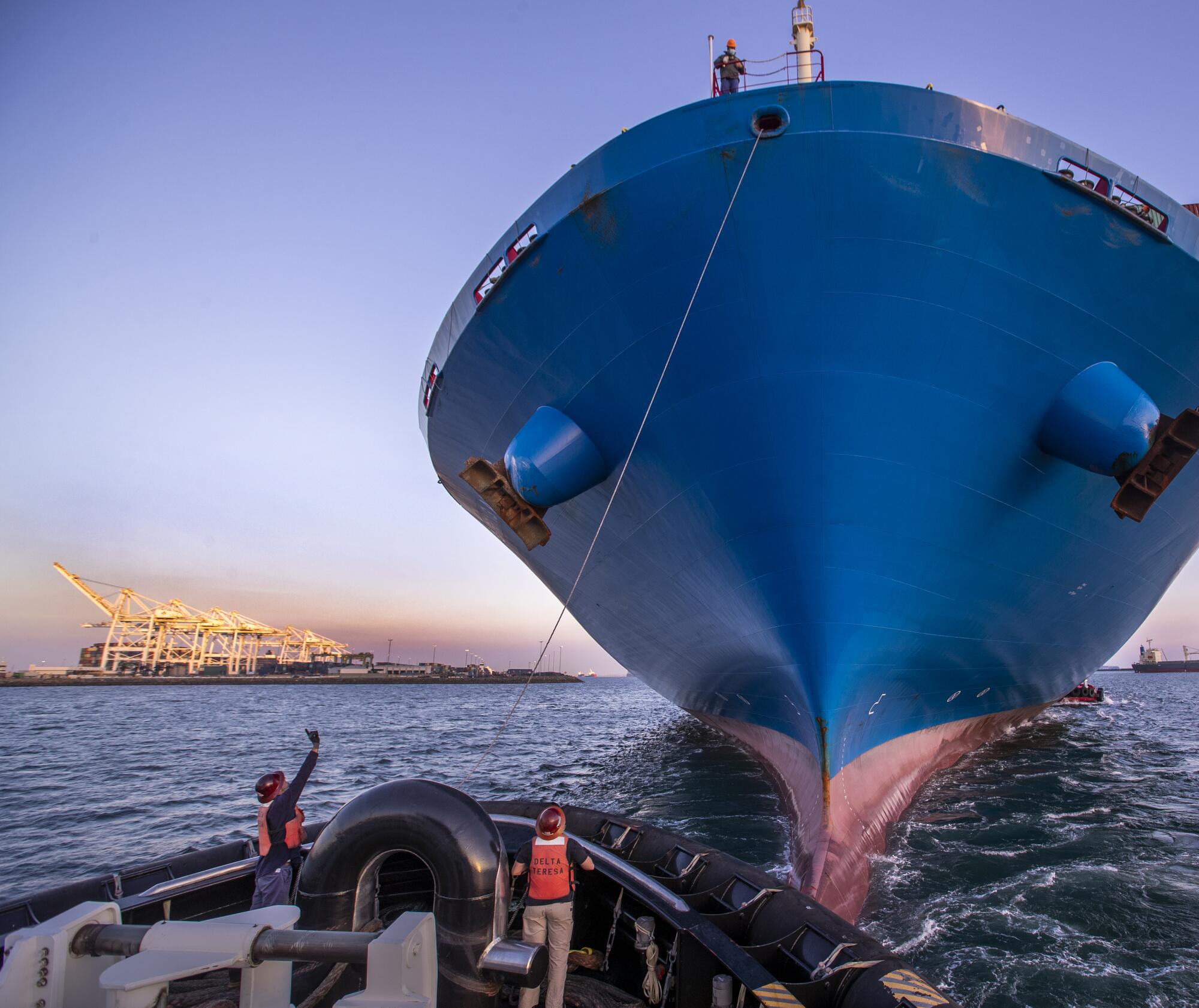
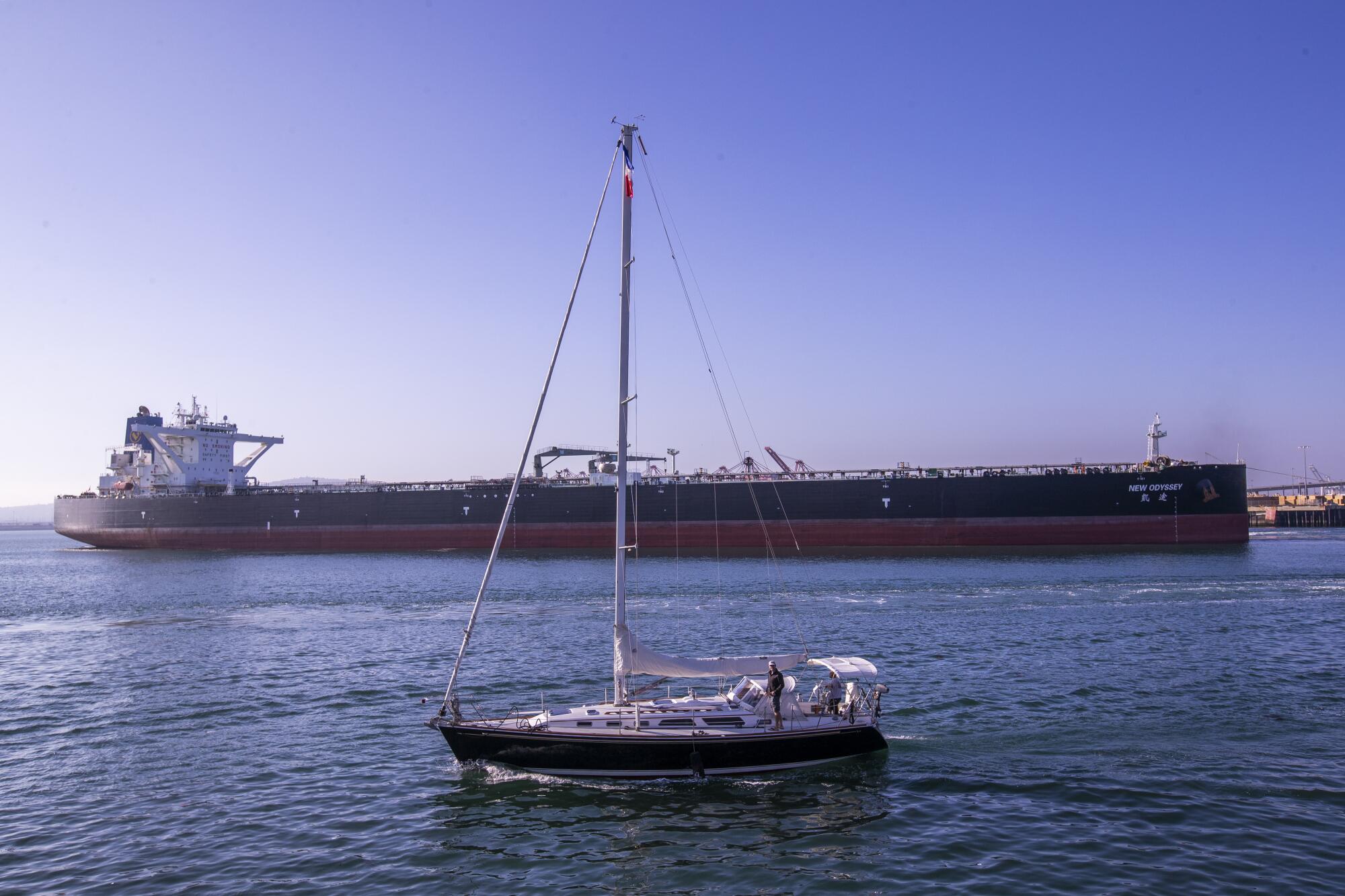
If today turns out like any other, they will escort at least four vessels to an assigned spot inside the Port of Los Angeles or Long Beach. Their work, guiding ships through narrow waterways to within inches of a dock, is both delicate and brutish. Fifteen tugs serve the two ports, and for more than a year, the pace has been relentless.
“Old-timers say that this is the busiest they’ve ever seen it,” says Johnson, who started working in Southern California two years ago. “Every dock is taken up, and if there is an opening, people are fighting to get there.”
On this early December day, between 1:30 a.m. and 10 p.m., the ports will record 12 arrivals and 14 departures with 13 ships shifting between anchorages. Each will need at least two tugs. The Marjorie C has the 5 a.m. slot.
“What happens when you pour seven gallons of water into a five-gallon bucket? You’ll get a mess. The ports were not designed to handle the surge that we have seen in the last 15 months.”
— Jock O’Connell, international trade economist
The crew members of the Teresa started their day an hour earlier, waking up in a dead-end back channel in Long Beach Harbor where they had tied up the night before. Dinner was orange chicken. They watched a movie and slept in their staterooms listening to the purr of the onboard generator and the rumble of the Matson container yard outside.
The congestion at the ports has drawn its share of ink, Johnson knows. Fingers are quick to point at shipping lines, terminals, truckers, but who’s to blame? Like cars backed up in traffic with no accident ahead, the slowdown is more frustrating than solvable. The culprit, if there is one, is the American consumer trying to make up for lost time.
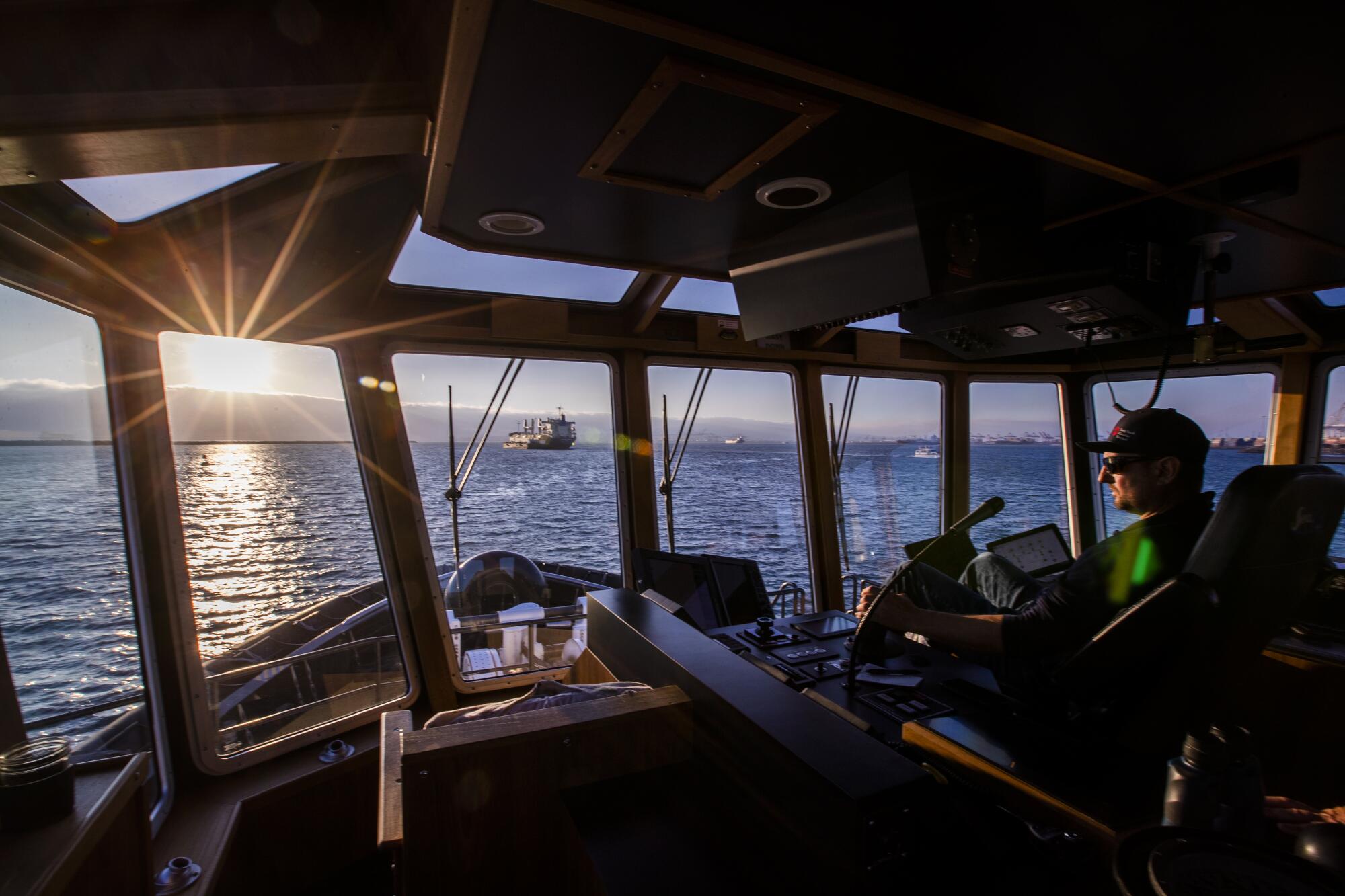
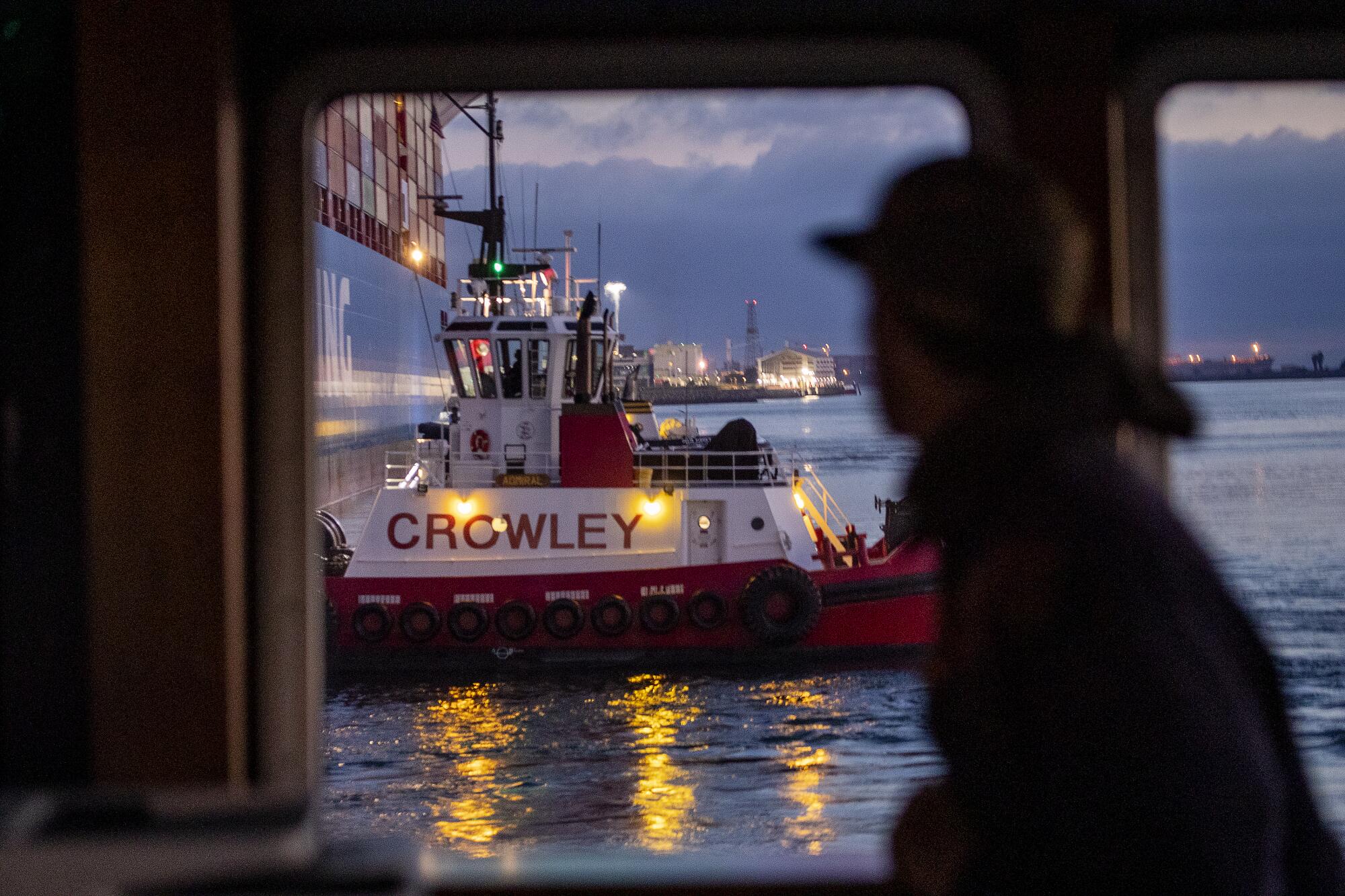
“And I’m just as guilty as the average Joe,” says Johnson, having just ordered off Amazon foul-weather gear from a French company.
Each day on the water, he sees evidence of a seemingly insatiable demand in the comings and goings of container ships, automobile carriers, oil tankers, even the Chiquita banana boat.
“Those of us who work out here see everyone’s lives writ large,” he says. “Every day we get a firsthand view of the size and scale of the American economy and American consumerism. Not many appreciate this when they go to the market and buy individual items.”
But waterfronts have always been forbidding places, the fenced-off realms of shipping terminals — 70 in Los Angeles and Long Beach harbors — crisscrossed by train tracks and truck routes and pinched together by bridges, causeways and landfills.
Steeped in arcane terminology and the habits of centuries past, they struggle today with logistical limitations in the age of next-day delivery and just-in-time inventories.
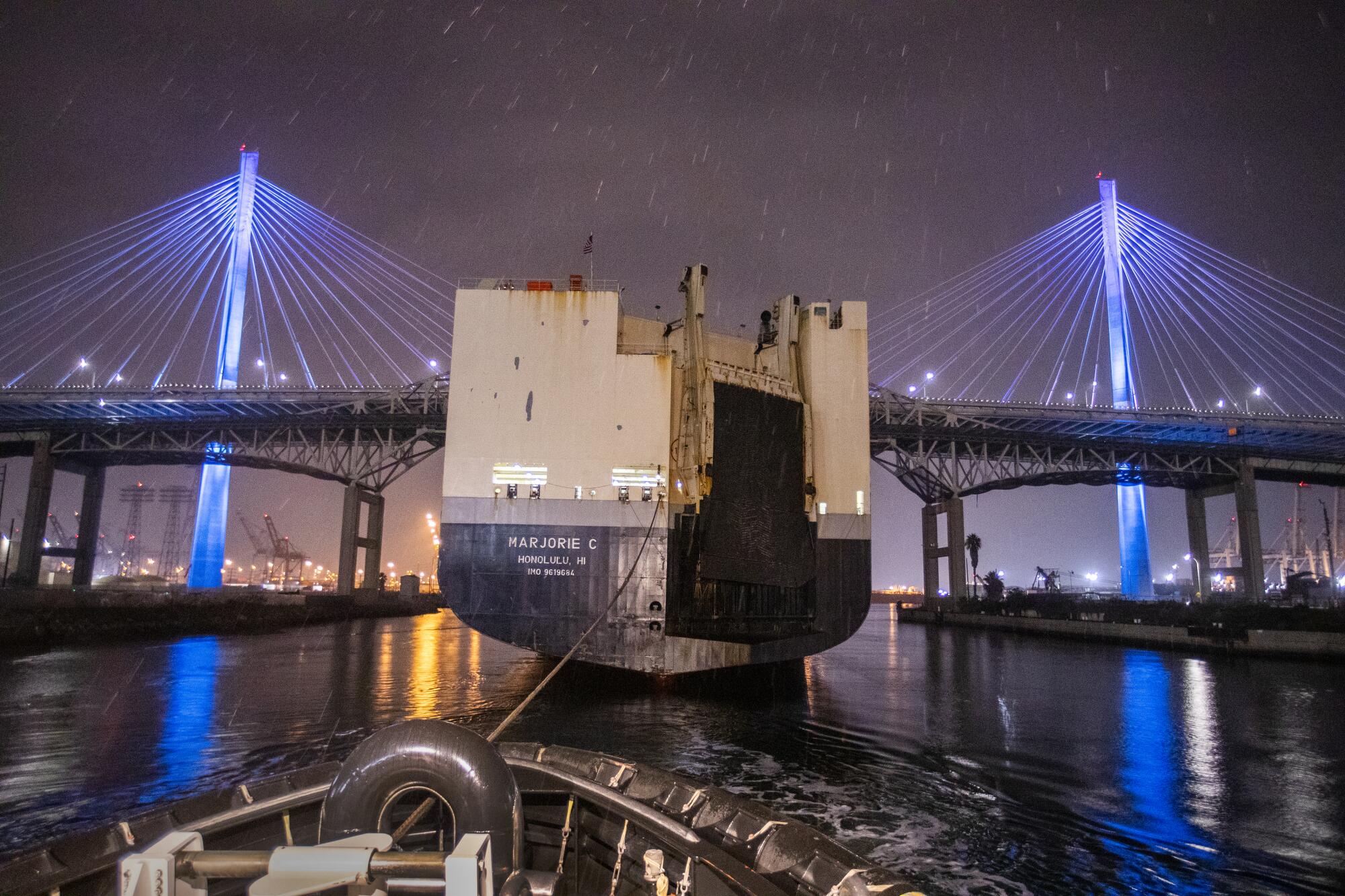
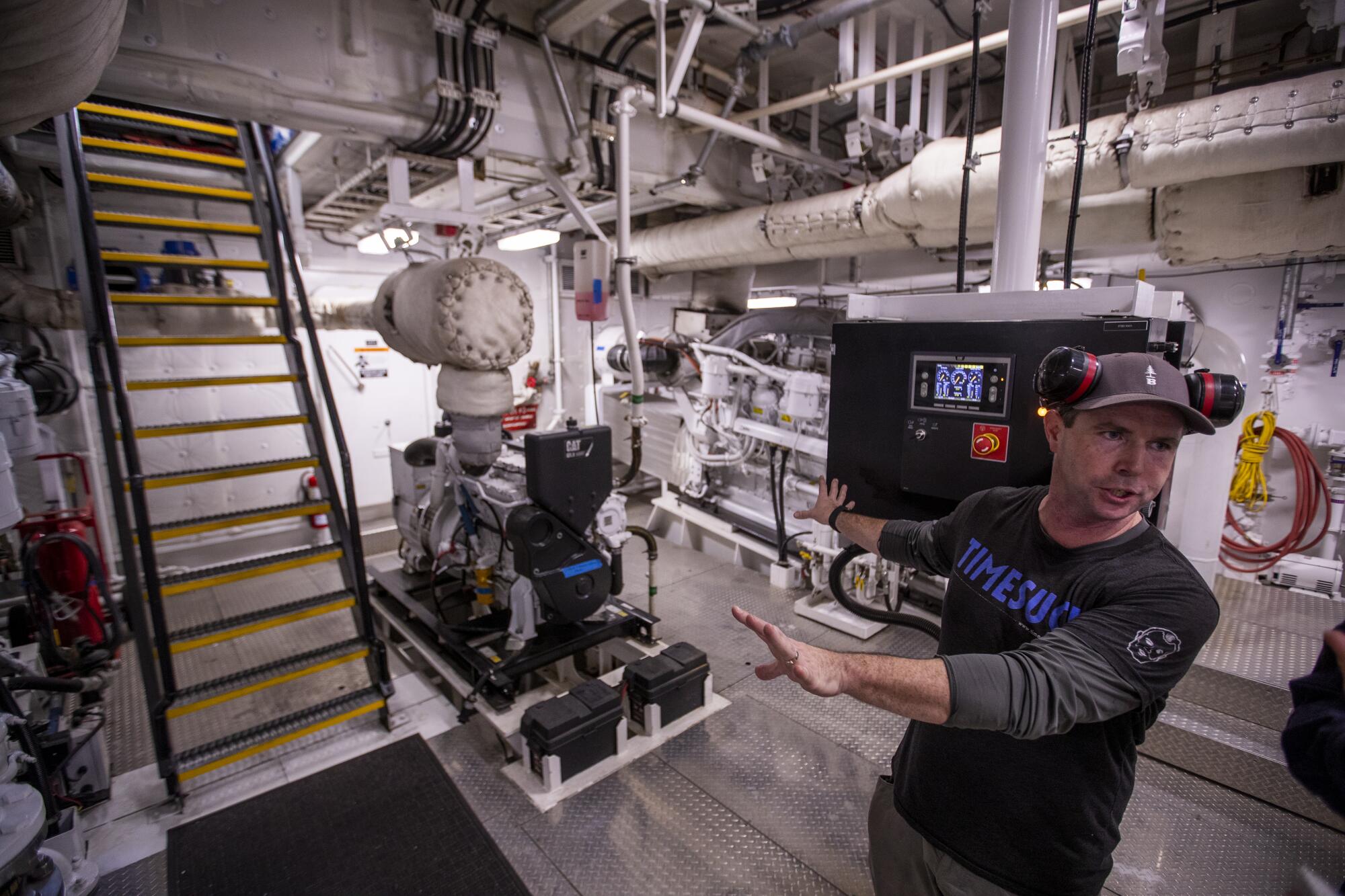
“What happens when you pour seven gallons of water into a five-gallon bucket?” asks international trade economist Jock O’Connell. “You’ll get a mess. The ports were not designed to handle the surge that we have seen in the last 15 months.”
The radio crackles to life, Channel 5.
“Good morning, Teresa,” says the pilot, who boarded the Marjorie C at a sea buoy one mile out. From its bridge he will take the ship into the harbor with the Teresa and the other waiting tug, the Delta Audrey, alongside.
“Put your line up on center-lead aft,” he tells Johnson, shorthand for where he wants the Teresa positioned: directly behind the ship. The Audrey will take the bow.
The Marjorie C’s running lights draw close. Its superstructure looms overhead. Johnson feels his adrenaline quickening. Perched in a captain’s chair, a padded-leather lounger with two footrests, he spins the Teresa around and drives into the larger vessel’s wake. The churning water buffets the Teresa as Johnson closes the distance, moving at a little more than 10 knots.
The tug has no steering wheel. Instead, two rotating hand grips — situated on his left and right — correspond to twin propellers that swivel 360 degrees beneath the hull. A tug is so maneuverable that Johnson equates it to a Rubik’s Cube: Driving it reminds him of solving a three-dimensional riddle.
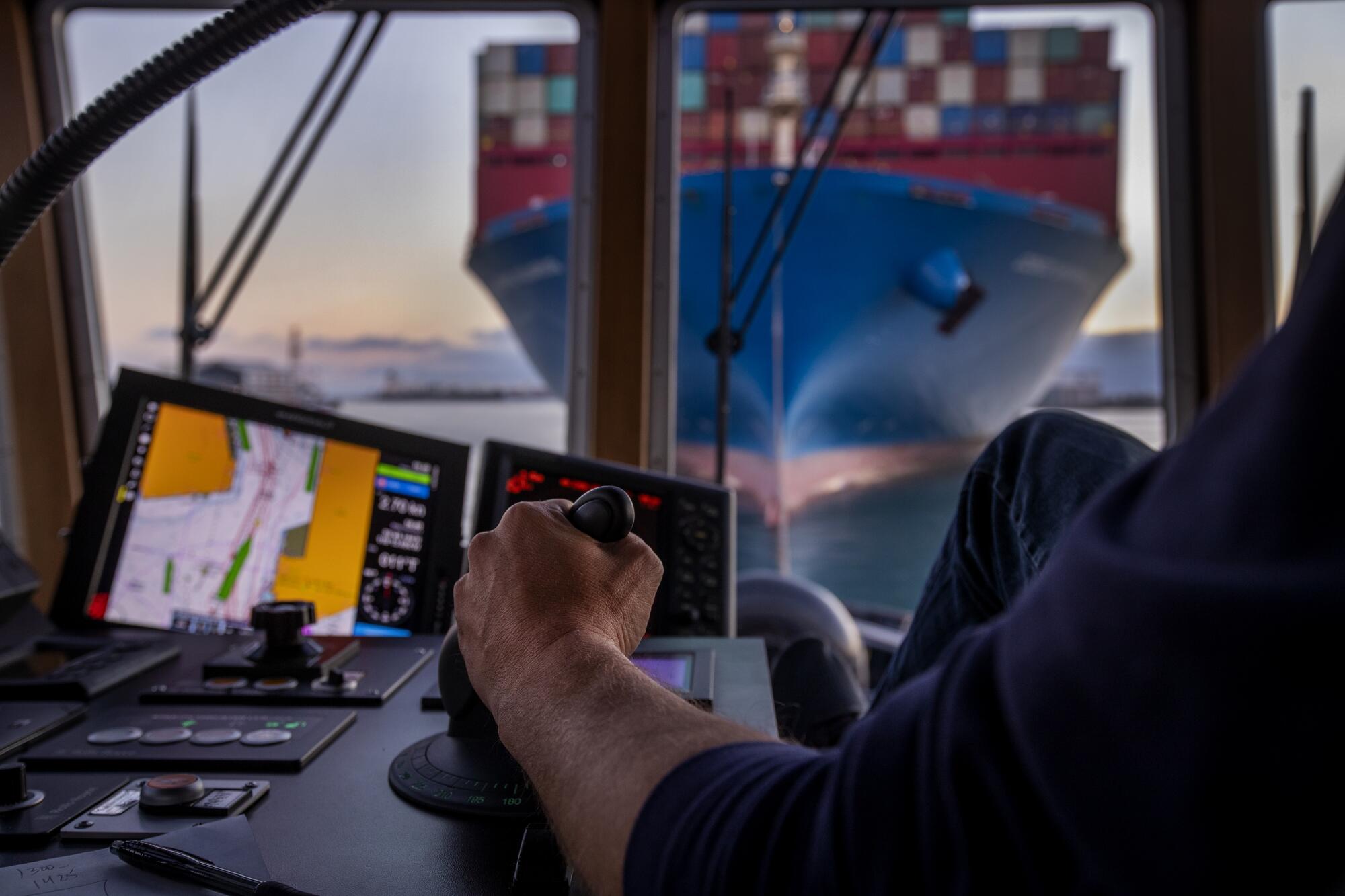
The throttles are two thumb levers — one atop each grip — that can deliver up to 6,600 horsepower and can pull 90 tons. Only locomotives, tractors and large farm equipment come close to having such power.
“It’s like driving a race car every day,” he says. Yet the real skill is exercising restraint. “Our tugs are so powerful that if you’re aggressive, you will overpower the ship.”
Johnson nuzzles the Teresa’s bow against the stern of the Marjorie C. Thick fenders cushion the impact. Cota and May don hardhats and life jackets and ready their lines on the lower deck.
The three men work silently, their focus honed by years of offshore experience. Johnson, 41, got his start piloting a dredge off the Louisiana coast. Cota, 40, pulled barges to China and delivered food to Haiti and West Africa, and May, 32, was chief mate delivering jet fuel and diesel around the Hawaiian Islands.
“You have to be perfect on every job. There’s no room for error,” says Johnson.
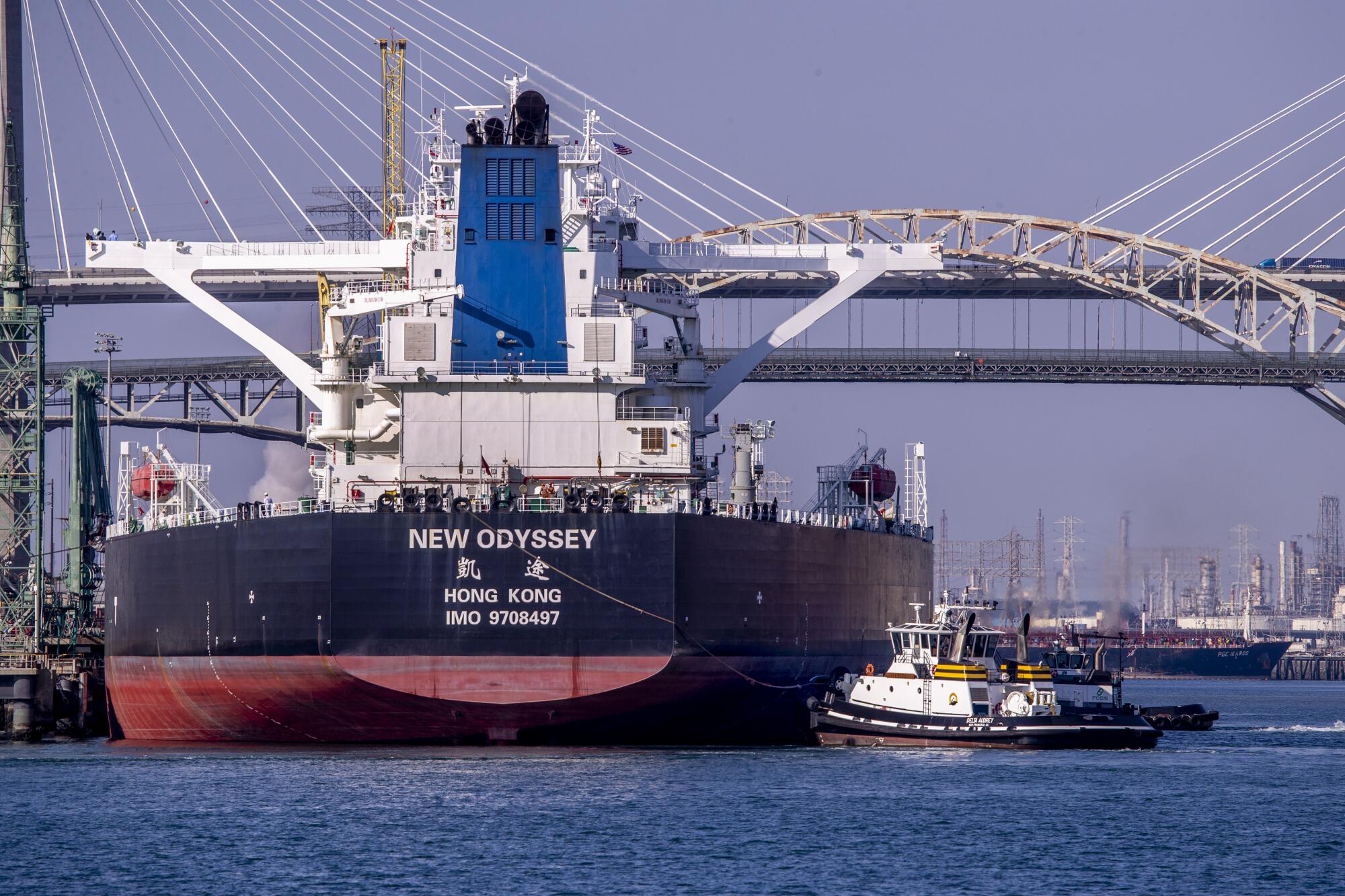
Boredom can quickly become terror or worse, he adds. In 2007, a tugboat deckhand working off El Segundo died when a tow line unexpectedly pinned her against a railing. Another mate was severely injured.
Johnson watches as a winch on the Marjorie C pulls up a 3-inch-thick braided nylon rope that connects the two vessels. Once it is secured, he allows the tug to fall back.
“Teresa is all fast,” he radios the pilot as he maneuvers the tug through the big ship’s washing-machine currents. He holds steady about 200 feet away, matching speeds and keeping the line slack.
The Marjorie C is a regular customer, running containers and vehicles between San Diego, Long Beach and Honolulu. Nearly 700 feet long and a little more than 100 feet wide, the ship is owned by Pasha Hawaii. Because it is American flagged and covered by a federal statute from 1920, it wastes no time waiting offshore.
“Transverse arrest, easy power,” the pilot radios. The time has come to start putting on the brakes.
Because the pilot wants to be able to steer the Marjorie C, its propeller must continue to turn, but its slowest speed is too fast, which is where the Teresa can help.
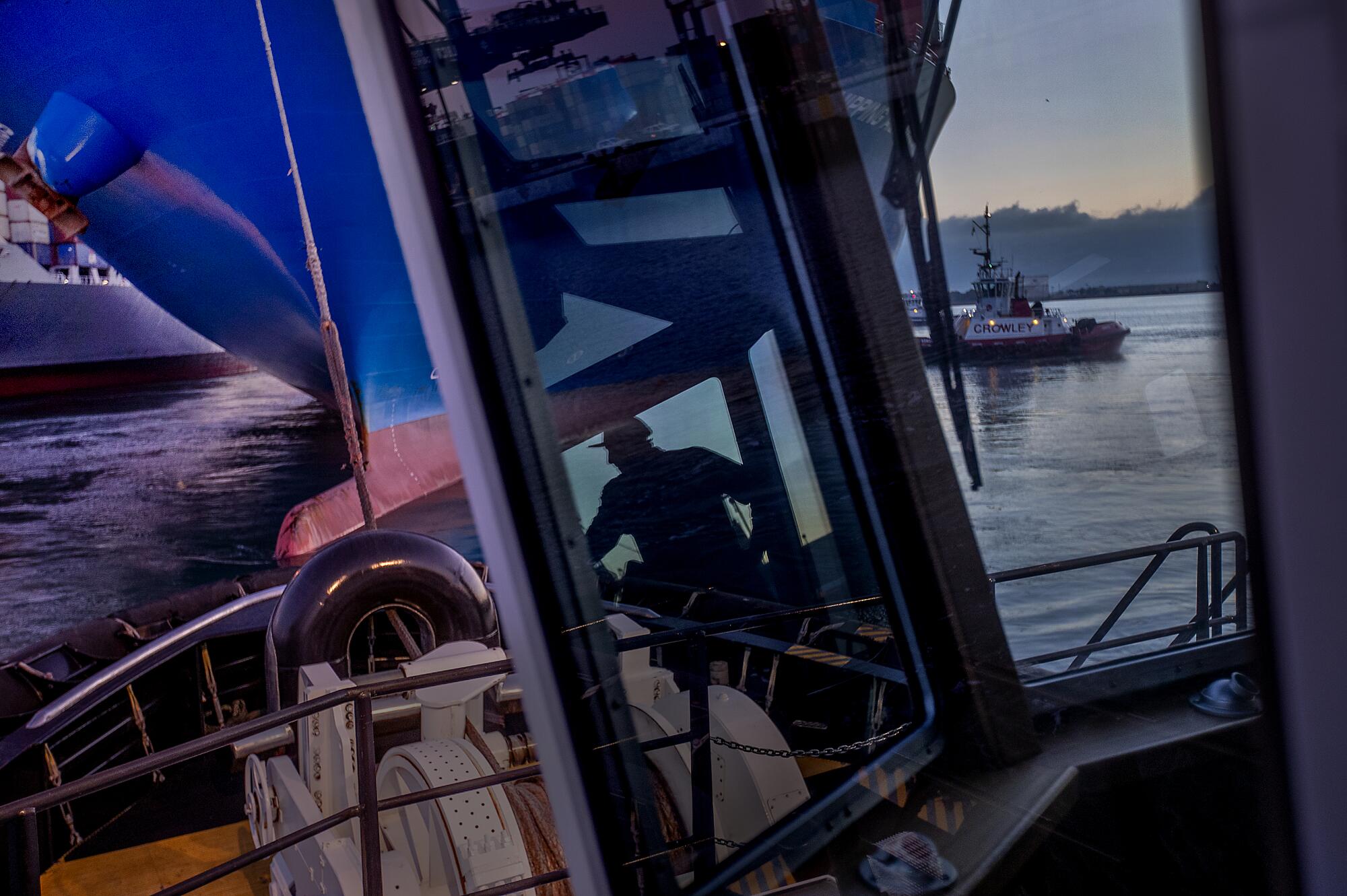
Swiveling his propellers sideways, Johnson uses the tug as a deadweight to act as an anchor to slow the Marjorie C.
The challenge facing the tugboat can be found in any high school physics text: momentum = mass x velocity. If Marjorie C is fully loaded and traveling at 10 knots, its forward momentum equals that of 4,000 cars on a freeway traveling at 70 mph, Caltech physicist Jason Alicea explains.
With the winch locked, the braided rope stretches tight, and the Teresa begins to shake and shimmy, fishtailing in the turbulence. Johnson keeps the course straight.
“That’s the irony of all this. The container system was designed to prevent bottlenecks, and for 65 years the system has worked fairly well. Now you’re hitting its limits. What is the next technological leap we can make?”
— Sal Mercogliano, maritime historian
Off the port bow, docks covered with wood products and container stacks emerge in the morning gloom. Off the starboard bow rise the so-called candy cranes (nicknamed for their red and white stripes) at the automated terminal where the largest of the container ships are tied up. At least twice a week, Johnson helps bring in one of those behemoths.
Rivaling the Empire State Building in length, mega-ships began arriving on the West Coast in 2015, creating a surge of cargo — up to 10,000 containers at a time — that even then were blamed for tying up the supply chain.
Maritime historian Sal Mercogliano with Campbell University in North Carolina wonders if the shipping industry is seeing the end of the revolution that truck driver-turned-businessman Malcom McLean started in 1956 when he put 58 containers on the deck of a converted oil tanker for passage to Houston.
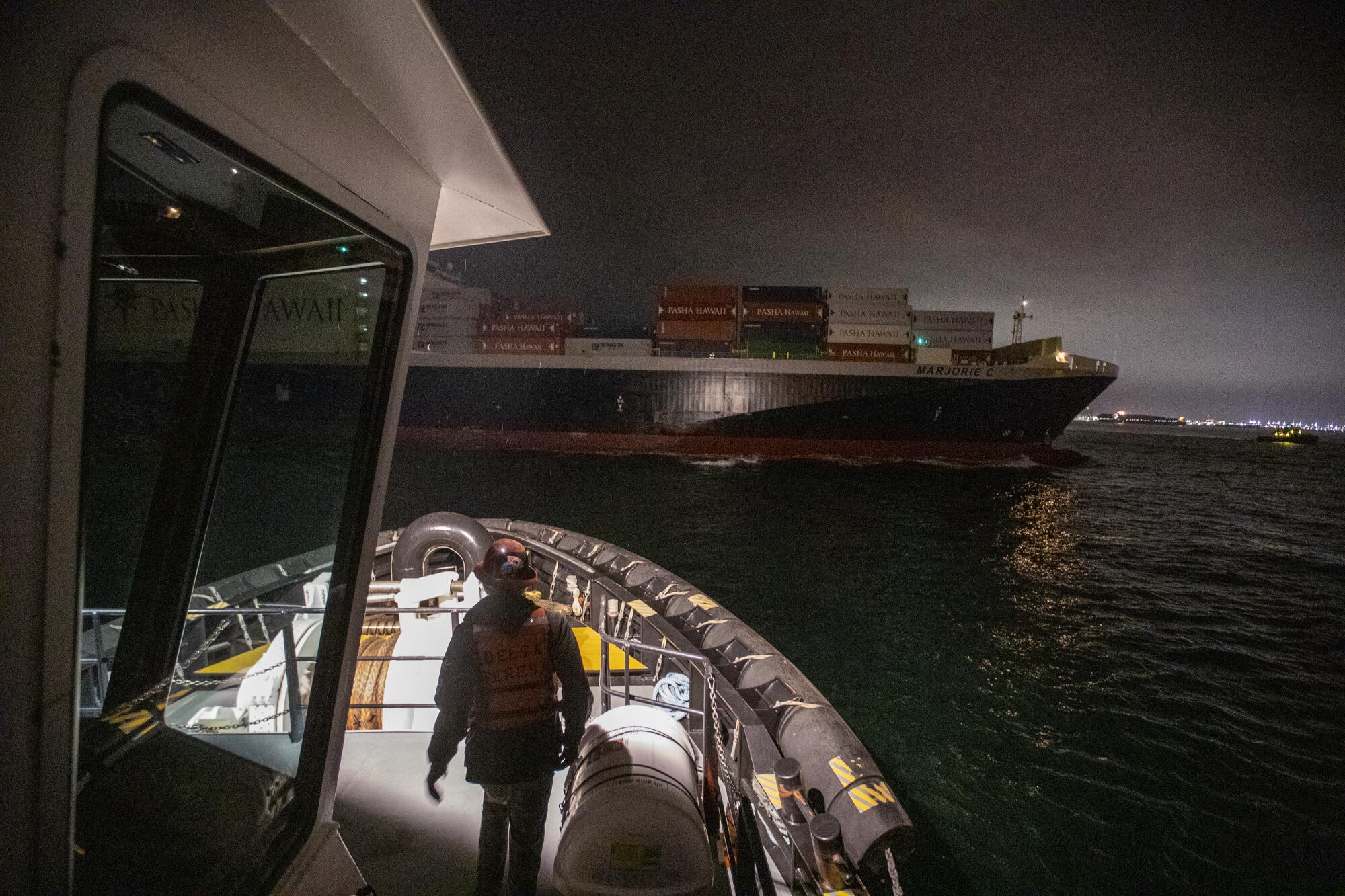
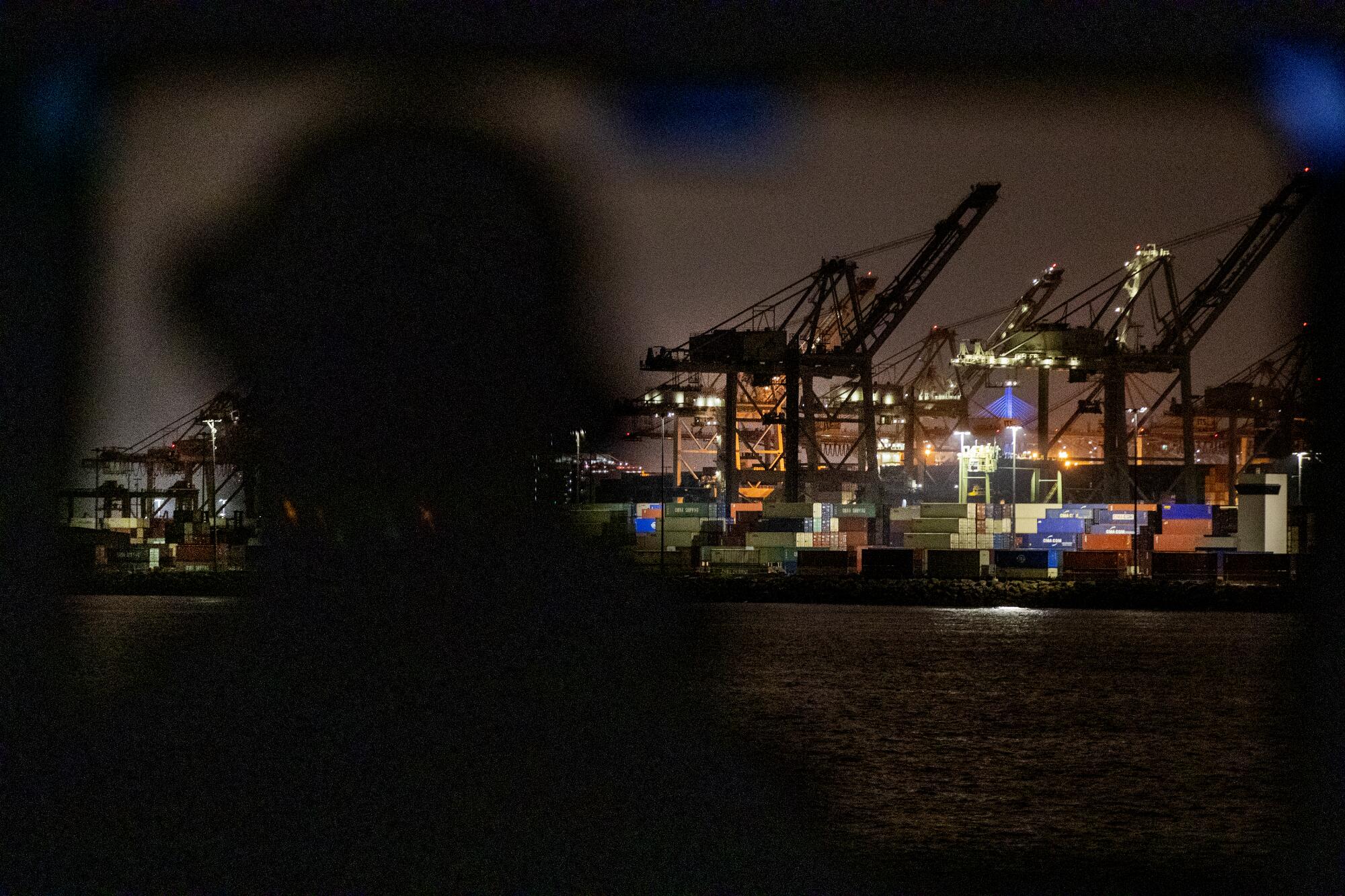
“That’s the irony of all this,” he says. “The container system was designed to prevent bottlenecks, and for 65 years the system has worked fairly well. Now you’re hitting its limits. What is the next technological leap we can make?”
As the Marjorie C and the Teresa enter the middle channel, the harbor begins to close in around them. A tanker, Pacific Sky, is offloading crude at a terminal almost 60 feet away.
“Pull in line, one-third power,” calls the pilot, asking Johnson to begin pulling with greater force against the Marjorie C. Johnson swivels his propellers to reverse, and the tug-of-war enters a new stage.
Still the large ship is moving too fast.
“One-half,” the pilot asks Johnson, who throttles up his engines.
The Teresa shakes, and the vessels are soon creeping ahead at 2.5 knots.
Growing up in the Bay Area, Johnson went down to the ocean at an early age, fishing off a local pier, taking dayboats to the Farallon Islands for halibut and salmon. When he turned 16, he wasn’t interested in buying a car; instead, he scrounged up money for a 17-foot skiff. Then out of high school, he enrolled at Cal State Maritime Academy in Vallejo.
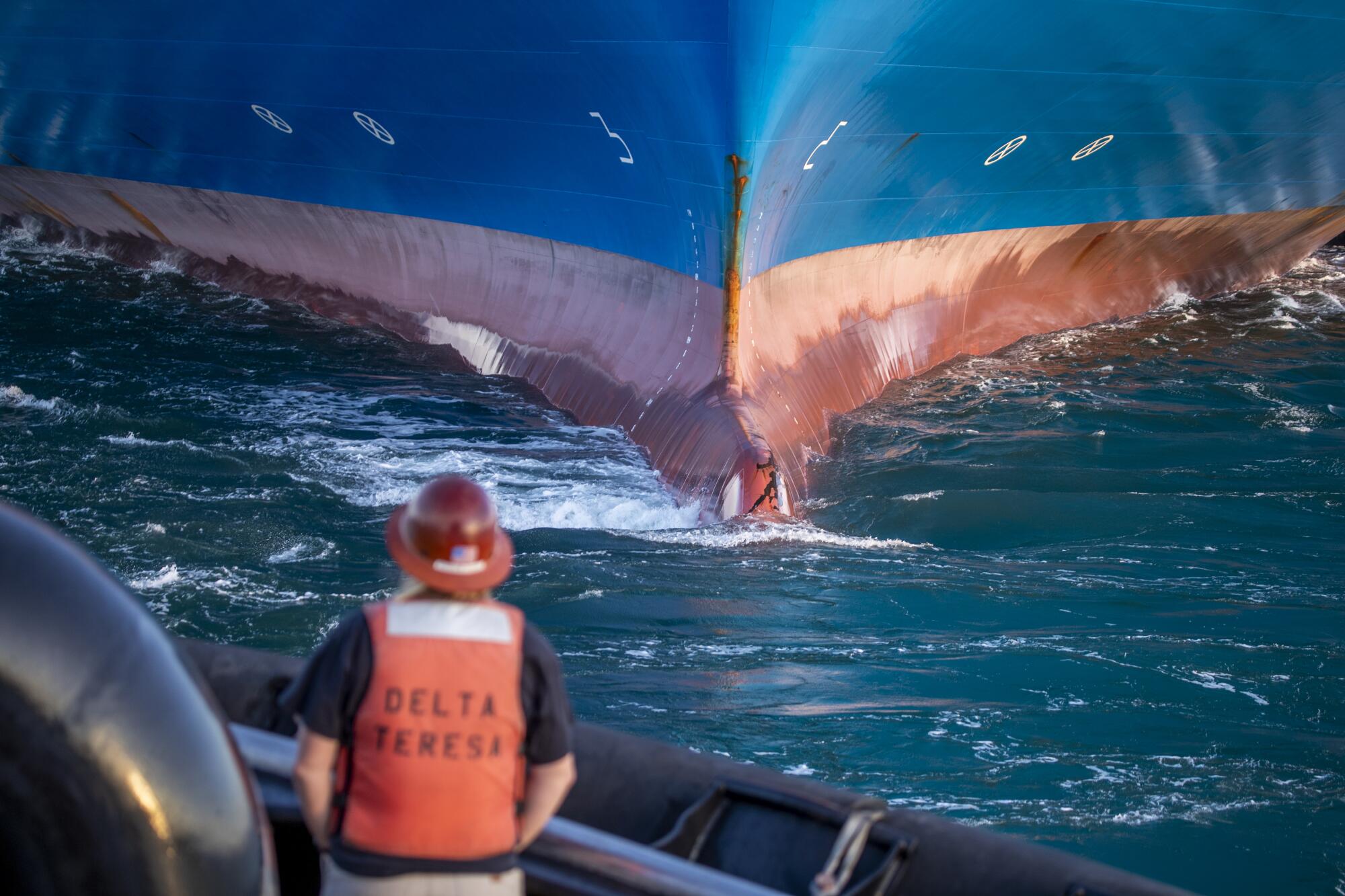
After nine years in Louisiana and a stint with another tugboat company in Alameda, he was hired by the Teresa’s owner, San Francisco-based Baydelta Maritime. Today, his commute is an hour flight up and down the coast once a week. He lives with his fiancee in Benicia on the edge of San Francisco Bay.
As the Marjorie C passes under the new bridge spanning the back channel, its cables lit blue against the gray sky, the pilot orders the Teresa to change position. Cota and May again head down to the lower deck.
A light rain is now falling. With few storms and little fog, the shipping lanes into Southern California are seldom shut for more than a few hours at a time, and unlike the Bay Area, wind and currents have little effect on ship movements. Johnson positions the Teresa against the port side of the Marjorie C. Cota and May retrieve the braided rope and reset it.
Soon the cargo ship and the two tugboats have slowed to a halt.
“Teresa, push bare minimum,” the pilot calls. Johnson responds, turning the Teresa perpendicular to the ship, and begins to nudge it sideways to the dock.
Having crossed the Pacific from Hawaii and sailed up the coast from San Diego, the Marjorie C now has a journey of inches.
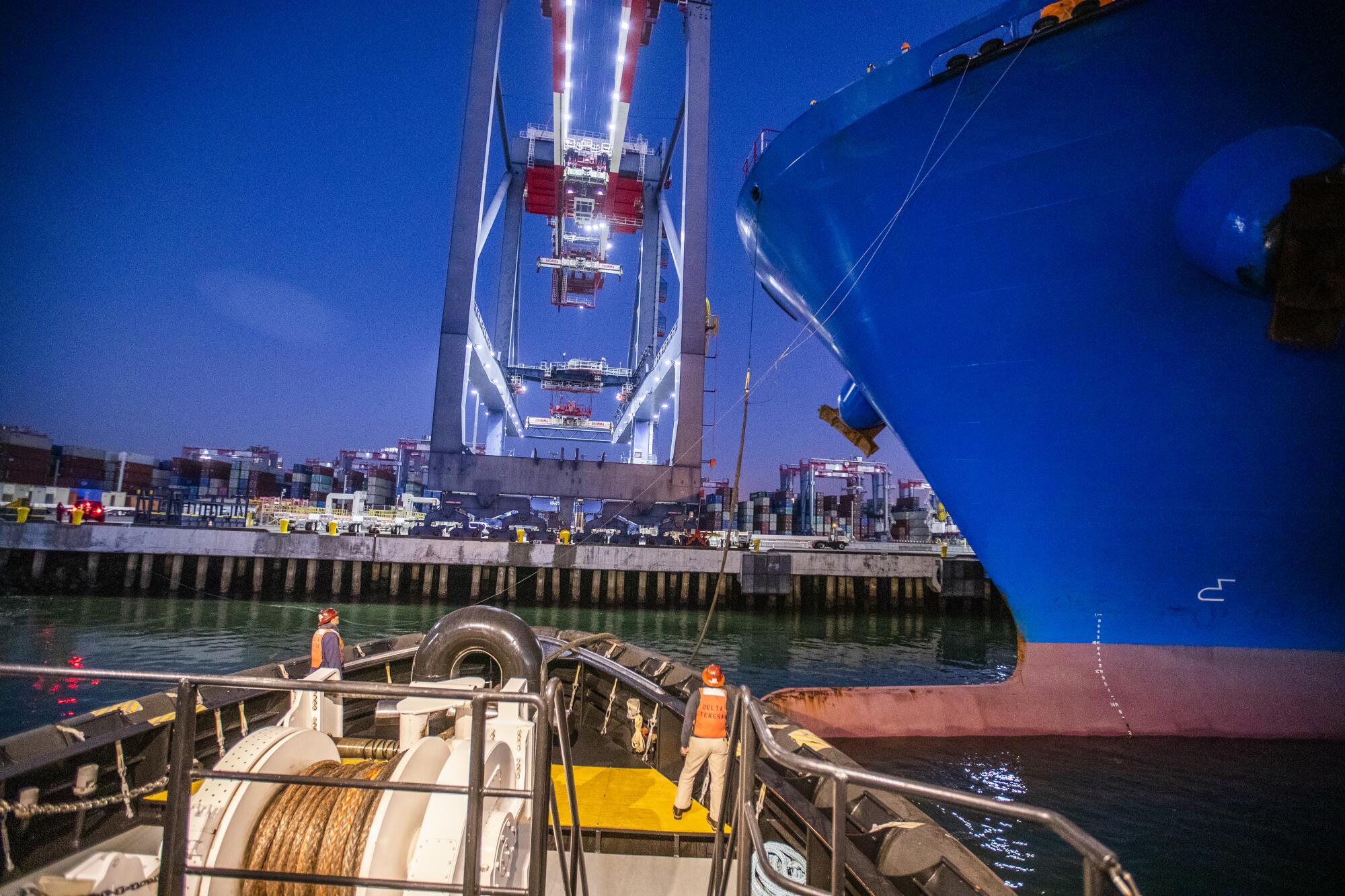
“Teresa, stop,” the pilot sends his last command.
The line handler on the Marjorie C lowers the braided rope back to the Teresa. The winch takes up the slack, and Cota and May coil the rope’s running end on the deck.
Johnson gets on the PA system. “Thank you,” he tells the crew of the Marjorie C as he pulls away. The hourlong dance is over. “See you soon.”
Dawn casts blue light over sea and sky. Seagulls wheel and mew. In 24 hours, the Teresa will be back, ready to escort the big ship to sea.
More to Read
Sign up for Essential California
The most important California stories and recommendations in your inbox every morning.
You may occasionally receive promotional content from the Los Angeles Times.










